DESCRIPTION
Fergusson had been drawn to sculpture from the early 1900s when he viewed the Benin bronzes shown in Edinburgh. His Paris notebooks also reveal an early interest in Cambodian and Indian carvings. He modelled his first figures in Paris before WW1 influenced by the avant-garde ‘primitivist’ sculptors Jacob Epstein and Henri Gaudier –Brzeska, whom he knew. Eástre, Saxon goddess of Spring, was inspired by his partner, Margaret Morris, who choreographed a ballet of the same title. His golden brass orb, composed of spheres and hemispheres, was he wrote the ‘effect of the sun [and its] triumph…after the gloom of winter.’
DETAILS
-
Artist
John Duncan Fergusson
-
Date
1971
-
Medium
Brass
-
Object number
309
-
Dimensions unframed
42 × 20 × 16 cm
-
Subject
-
Copyright
© Courtesy of The Fergusson Gallery, Perth & Kinross Council
ARTIST PROFILE
John Duncan Fergusson RBA, 1874-1961
Born in Leith, John Duncan Fergusson’s youthful determination to become an artist was underwritten by his wine merchant father, leading to stints at two Paris Académies in the 1890s while on painting trips abroad. He finally settled in Edinburgh where his close friendship with Peploe led to a shared commitment to painting highly accomplished works that echoed the techniques of old masters and French moderns.
His full time move to Paris in 1907 plunged him into the social and artistic ferment with its exhibitions of Picasso, Matisse and Braque. Within months he was showing radical new work, influenced by the Fauves, at the progressive Salon d’Automne. In time Fergusson allied himself to a splinter group of the Fauves known as the Rhythmists, becoming founding art editor of its journal.
A well-built, handsome swagger of a man, Fergusson had always been drawn to charismatic, confident women. The love of his life was Margaret Morris, one of the most innovative choreographers of the early 20th Century, whom he met in Paris before WW1.
The couple spent the war years in London moving back to France between the wars, where Fergusson’s produced a stream of landscapes and portraits that harked back to his pre-war colourist period and absorbed the innovative techniques of cubism. In 1939, Fergusson and Morris settled in Glasgow, where they remained for the rest of his life, revered as the Grand Old Man of the Scottish avant-garde.









